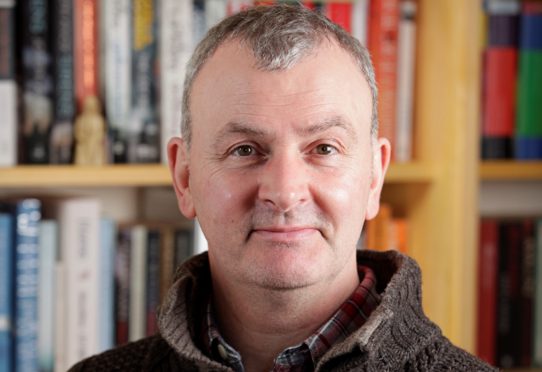When Robin Crawford and his wife Angie were walking on the Isle of Lewis, a tractor came past with a trailer full of peat.
“Someone ought to write a book about Scottish peat stacking,” Robin idly commented, to which Angie replied: “On you go then.” So he did – and the result is Into the Peatlands: A Joruney Through the Moorland Year.
Robin, the manager of Waterstones Dundee, is a sculptor by training and was drawn by the cutting processes and the patterns of the peat stacks.
“I come from a family passionate about books and art, and the two have always been intertwined in my life,” says Robin, who studied at Duncan of Jordanstone College of Art in Dundee.
“It was here I discovered my love not only of sculpture but also of art history.”
Partly drawing inspiration from the success of the book Norwegian Wood which had been a popular gift the previous Christmas, about the Scandinavian art of wood pile stacking, Robin explains his passion for peat.
“I guess there were three things that initially appealed to me about peat. Firstly the wonderful nature of moors and bogs where it is formed from layer upon layer of tiny sphagnum mosses.
“These water-loving plants are ideally suited to Scotland’s damp, moist North Atlantic climate. They flourish in a myriad of forms, colours and textures with other specialist bog plants to form a tiny but beautiful tweed that reveals itself when you venture out onto these half land/half water places,” he says.
“There is a rich variety of wildlife on the moors; I was particularly drawn to those which, like people, would spend a season on the bog and then depart – cuckoos, geese,and swallows; tadpoles and frogs, lizards; caterpillars and moths.
“Secondly is its ability to hold within itself a historical record. As the living mosses die they gradually form layer upon layer of peat – at a rate of about 1mm per year – and within these layers they capture an essence of the world around them,” he continues.
“A typical bog may be three metres deep so when in my researches I joined a scientist on a Dumfriesshire bog and dug deep down into the core of it with a special spade we brought up samples of pollens and plants that have grown in or around the bogs since they were formed years ago.
“There were molecules of ash from Icelandic volcanoes that erupted in medieval times, pollutants from the Industrial Revolution, nuclear fallout from Chernobyl.
“This ability of the peat to hold within itself these tiny particles is giving environmentalists hope that by restoring the health of Scotland’s bogs we can capture the polluting carbons that are driving global warming. Another side to that preserving quality is the peat holding on to anything that falls, or is thrown into, its quagmire depths – crofters’ sheep and cattle, macabre bog bodies sacrificed to Iron Age gods or Roman coins, Robert the Bruce’s sword, a wooden churn of 17th Century butter,” he continues.
“And thirdly there is the whole culture of the cutting, drying, transporting, stacking and eventual burning of peat as a fuel. In these times where we hear of fuel poverty, peat plays a vital role in the multi-fuel options for the people who live in Scotland’s peatlands.
“As the price of oil increases so too does the amount of peat cutting. It is cut by families in places where for generations their ancestors have cut, using the same tools and methods handed down, building their sculptural peat stacks, often in very beautiful patterns – herringbone like the tweed they weave in sheds, beside which their peat is stacked.
“The peat stack is in a constant state of flux – once built it is immediately deconstructed, diminishing through the year until all the slabs of peat are burnt, only to be rebuilt again with a new load of peat. Over the years the people, like the individual slabs of peat, change as new generations take on this traditional task. I find that quite moving.”
And of course peat is not just burnt for domestic use but also commercially, as a vital ingredient in the making of whisky.
“Even Japanese distillers will import peat from Scotland to try and emulate our country’s unique malts,” says Robin.
Travelling all over Scotland in his researches, the book is divided into seasons with a different moor or bog featured each – Kirkconnell Flow, Dumfries in spring; the Isle of Lewis in summer; Flanders Moss, Stirling for autumn; and the Rannoch Moor for winter.
“I end the book looking forward to a new spring and wondering what the coming seasons will bring for our peatlands.
“The book took three years from inception to publication and I did a lot of reading and visiting bogs, museums and archives all over Scotland and in Iceland too. The best experience was listening to people who were always very generous with their time in telling me their peat stories, a real pleasure.
“The oddest sensation is selling a customer a copy of the book and wondering if I should say I’m the author. Weird!”
Into the Peatlands: A Journey Through the Moorland Year by Robin A Crawford, Birlinn, £12.99.










